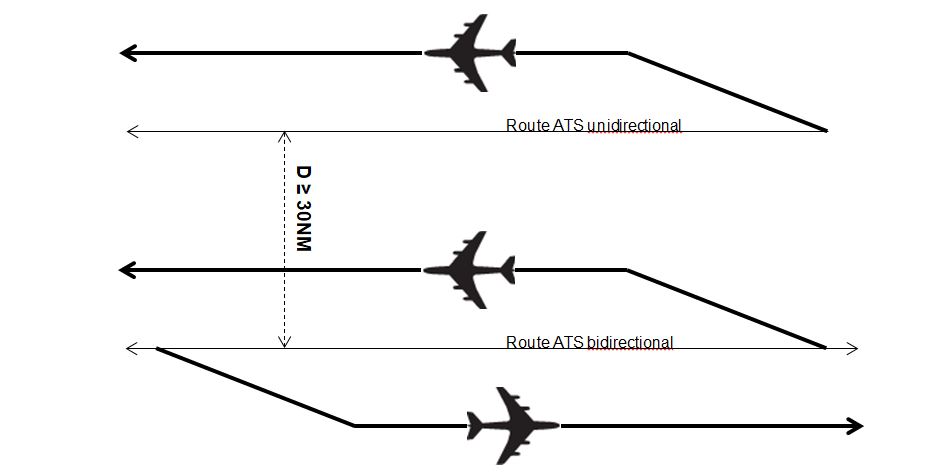¶ Introduction
Strategic lateral offset procedures (SLOP) are approved procedures in oceanic and remote continental airspace that allow aircraft to fly on a parallel track to the right of the centre line relative to the direction of flight.

This procedure requires authorization from the appropriate air traffic controller responsible for the airspace concerned.
The rules of the air require that aircraft operating controlled flights shall, when on an established ATS route, operate along the defined centre line unless SLOPs are authorised on that route by the appropriate air traffic control unit.
¶ Definition
The strategic lateral offset shall be established parallel to the designated ATS route at a distance of 1.85 km (1 NM) or 3.7 km (2 NM) to the RIGHT of the centre line relative to the direction of flight.
SLOP is applicable in selected airspaces to pilot's discretion and ATC should not be informed about it.
These two track options (1NM and 2NM) become available in addition to the track centre line, not instead of it.

¶ Usage
The decision to apply a strategic lateral offset shall be the responsibility of the flight crew (pilot-in-command). The flight crew shall only apply SLOP in airspace where such offset has been authorized by the appropriate authority and when the aircraft is equipped with automatic offset tracking capability.
SLOP procedures are used to limit the increase of probability of loss of separation.
The increasing accuracy of en route navigation has had the effect of increasing the probability of loss of separation:
- Between traffic which is not operating in accordance with the correct air traffic control clearance
- Where an error has been made in the issue of an air traffic control clearance
- In case of loss of vertical separation between aircraft on the same route, in particular where movements take place outside areas covered by ATC surveillance service.
Such areas may be encountered during transit over oceans or remote continental areas.
SLOP procedures have been designed to include offsets to mitigate the effects of wake turbulence of preceding aircraft.
If wake turbulence needs to be avoided, the aircraft can choose one out of 3 possibilities:
- Runway centre line
- 1.85km (or 1NM) right offset (SLOP)
- 3.7 km (or 2NM) right offset (SLOP)

Pilots are not required to inform air traffic controllers that a strategic lateral offset is being applied.
¶ SLOP under air traffic control
All ATC route clearances are made without reference to the lateral offset option and flight crew do not need to obtain permission from ATC to use these offset tracks or advise ATC of their decision to do so.
If there are areas of radar surveillance, within trans-oceanic or remote continental areas, designated for lateral offset procedures, then it is expected that aircraft will be allowed to initiate or continue offset tracking in exactly the same way as the rest of the designated area.
ATC shall be aware of the availability or not of the SLOP procedure under his airspace.
¶ Parallel ATS routes
SLOP cannot be operated if parallel route centrelines are less than 30 NM apart.

SLOP may be authorized for unidirectional and bi-directional routes (see example above).
¶ SLOP constraints for pilots
Aircraft flying offset tracks shall have automatic offset tracking capability. This capability can be found in modern Flight Management Systems (FMS).
Flight crews are expected to determine the most suitable track using the best traffic information sources available to them. Communication with other aircraft in the vicinity using the air-to-air frequency (UNICOM 122.800 MHz for IVAO) may also facilitate useful coordination.
The procedures to be followed when applying strategic lateral offset should not be confused with the weather deviation procedure.
¶ Where is SLOP authorized?
It is an expanding list. As of 31 Dec 2013, we found:
- Africa, various locations
- Australia administered OCA
- China, on routes A1, L642, M771, and N892
- New York, Oakland and Anchorage Oceanic FIRs
- Oceanic airspace in the San Juan FIR
- The entire North Atlantic Track Region
- The Pacific (including the NOPAC, Central East Pacific (CEP) and Pacific Organized Track System (PACOTS))
- South Pacific airspaces
- None
- ICAO Documentation 4444 - Air Traffic Management - 16th Edition 2016 - Chapter 16.5
- VID 150259 - Creation
- VID 256272 - Wiki Integration
- VID 496402 - Wiki.js integration